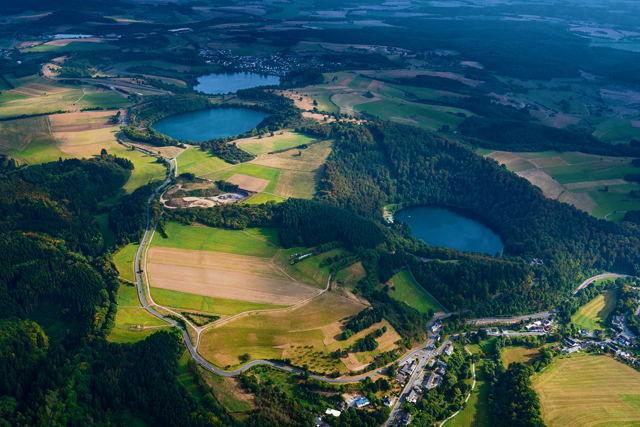
If you’re looking for a day trip that blends interesting history, fascinating geology, beautiful driving, and outdoor activities, Germany’s Vulkaneifel region is a must.
A quiet land that wasn’t always so quiet
As with most German words, Vulkaneifel seems solid and efficient, since it brings together a descriptor (Vulkan) and a place name (Eifel). In this case, the place is straightforward enough: The Eifel is a beautiful, quiet region split between North Rhine-Westphalia and Rheinland-Pfalz, and it lies east of Luxembourg and southern Belgium.
But Vulkan means ‘volcano.’ And volcanoes are awesome — especially extinct volcanoes.
However, the land beneath the Vulkaneifel region is far from extinct, volcanically speaking. The Eifel volcanoes were formed from something that geologists call a “hot spot,” which is interesting because it’s not related to tectonic plates, like most other volcanic activity is. So even though the region’s nearly two dozen ancient volcanoes are now just lovely tree-covered hills rising from the horizon, the hot spot beneath the Vulkaneifel is still active.
That being said, the last volcanic eruption in Germany was approximately 10,000 years ago, which is relatively recent in geological time. But still long enough ago that the area is perfect for modern visitors.
What to do
As one might expect, the Vulkaneifel is excellent for outdoor activities, including hiking, walking, and cycling. It also offers some of the most beautiful and relaxing driving in Germany.
But to really do German volcano country, it’s best to get out there and get your feet wet —sometimes literally. Highlights include:
Swim in a maar: A maar is a lake that has formed in a volcanic crater. Technically, maars are not ‘crater lakes’ because they were formed by gas punching holes through the earth. But they’re still beautiful, and they’re still outstanding places to swim, soak, sail, and relax when the temperatures get warmer. Some of the best ones include the Meerfelder Maar and the Pulvermaar Nature Pool.
Visit the Windsborn Kratersee: Okay, so this is an actual crater lake – the only one north of the Alps, in fact. It’s a lovely, almost mesmerizing place, especially when considering that it was once a seething, lava-filled volcano. Though swimming isn’t allowed, there is a nice hike that takes visitors around the lake.
Hike to the Dreimühlen waterfall: Water-falls are always cool, but this one is especially interesting because it grows each year (approximately 10 cm, but still), thanks to its unique geological makeup. Located near Nohn, the waterfall is approximately a mile away from the parking area, and is worth it.
Visit the Wingertsbergwand: If you want to get a glimpse of what a volcanic eruption does to the earth, you have to visit the Wingertsbergwand. A monument with a 150-foot-tall cliff, this place is a must for those interested in volcanoes. Open year-round, the site offers great information — it’s basically like reading a diary of an eruption — and is easily accessible.
When to go
The Vulkaneifel is beautiful year-round. Warmer weather is better, of course, to take advantage of swimming or any activities related to the maars. But the scenery is drop-dead gorgeous in the autumn. And even winters are fantastic, especially when the Dreimühlen waterfall freezes.
Getting there
By car, reaching the Vulkaneifel region is approximately 1 hour and 45 minutes from Kaiserslautern.
Due to regulations to prevent the spread of COVID-19, please verify the status before making plans to attend. For U.S. government employees, including service members, remember to always follow command regulations, which may be different than host nation policies.


